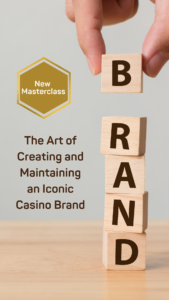The field of casino marketing abounds with smart, resourceful mavens. I recently had the opportunity to ask a few of them for their go-to casino marketing strategies.
A 25-year veteran marketing strategist and Casino Marketing Boot Camp coach, Mary Loftness has spent a career driving the measurability of marketing and the need to track everything. Mary is ever-focused on yesterday. That is, she looks to beat last year’s revenue each and every day. She suggests, “Compare the similar day and look to creatively improve the promotion, special event, or direct offer to increase revenue. Keep a detailed library of business drivers each day with notes for successes and failures. Continuous steady improvement wins!” This daily focus makes big goals achievable as you look to improve step by step rather than through leaps and bounds.
USE YOUR DATABASE
Nicole Barker is a database and loyalty specialist committed to improving the industry’s marketing skillset to court customers effectively. Her go-to strategy is to create a unique program for the customers that somehow seem to be off the competition’s radar. “Every database, be it large and small, has a gaming budget tipping point. $100 ADT is that tipping point. Programmatically, your competitors set their player development (PD) sights much higher. Mine the doldrums in between $100 ADT and your PD threshold for your greatest incremental revenue potential. The players will be delighted. Your reinvestment won’t be that much. Moreover, long-tailed loyalty will abound.”
Lynette O’Connell has been both a co-worker and a friend for years. She is a fan of the classic Recency, Frequency, Monetary Model, commonly referred to as RFM
“One of the first places to start when leveraging your database is the RFM model. Sometimes, I also include Locality. These figures are critical in ensuring you are reinvesting in your players accurately. I have been to locations where the sole focus is on Monetary (usually ADT)” which does not account for the multitude of influences on a visit.
How to start? O’Connell suggests, “My first recommendation is to add Frequency/Trip. Why? Let’s look at two players: Player A comes in twice a month and plays to an ADT level of $100. Player B comes in 20 times a month and also plays to a $100 ADT. Which player is more valuable?
Obviously, Player B. However, if ADT is the only criteria in a segmentation matrix, then they are both being treated the same. To resolve this, I suggest looking into the database to find the average number of trips for your active players. Often, this is around four trips. If you have a highly frequented property, then it could be higher. Once you know the number, anyone below the Average Trip gets segmented by ADT, anyone above the Average Trip gets segmented based on Average Monthly Theo (AMT). With this in mind, you can begin treating the more frequent loyal players based on their true value and spend at your property.”
This is only the beginning. In addition to reinvestment, you can also begin to look at the goals of each of these segments. For lower frequency players, you may try to increase trips. For the higher frequency players, you could attempt to extend their length of play (since you probably won’t get more trips out of them). Build your marketing offers around these goals to entice the behavior you are looking for from your customers.
“There are several more layers to segmentation, but this is a good place to start,” continues O’Connell. “I always suggest doing an A/B test when you are making strategic changes to validate what is (or isn’t) working. This will further aid in quantifying and reporting the ROI you see from the modifications.”
THERE IS GOLD IN YOUR DATABASE
Your decliners and inactive customers might be your best source of revenue. For whatever reason, you have a segment of customers that have chosen to visit less often or not to return. It’s fair to assume they experienced something unsatisfactory in their past visits. But, ask yourself, “How much revenue can I bring in if I get only 1% of those customers back for a visit?” What if you can get 2%? 5%? 10%? This will take time and will likely be a test of your general manager’s patience. To regain this customer, you may first need to do an internal audit of your offerings, services, facilities, and staff — an honest one. Then, audit your competitors. You must identify both the improvements you have made since their last visit(s) and the upgrades you can make now. This should be done before you drop an offer in the mail. Once you have a new story to tell, then bring in your direct mail team to understand what the optimal offer might be. Combine that with the right message to see an improvement in this segment.
REACH OUT AND TOUCH SOMEONE
From “across the pond,” player development expert Jackie Parker recommends a warm welcome.
“We can all agree that a high-worth customer should be assigned a host and immediately go into the direct mail programs to keep them coming back,” starts Parker. However, should this be the first step in the relationship we are only just starting to build with them? “We’ve become very proud of our industry processes and procedures, but too much reliance on automation can overshadow the value of a friendly voice. The key term to remember is relationship. Frankly, that requires a human touch,” stresses Parker. “There is a big difference between a direct mail welcome and a personal one.”
Parker continues, “A valuable new player should receive a phone call within 24 hours if they met the threshold theo on the day that they enrolled. These top players expect personal recognition and to feel special; it isn’t good enough to wait for the direct mail programs to catch up with them.”
These welcomes don’t just have to fall on the shoulders of your host team. You can probably set up an easy report that can be split up between the players club staff, or anyone who would love to be a part of the welcome wagon.
Parker offers a second strategy: keep in touch. She says, “You want your player development team to remind customers of your casino when they are missing events or you haven’t seen them in a while, but you can’t just call and ask, ‘Where y’at?’ Hosts need a reason to call (RTC) because otherwise, the phone call is just a begging request to come back and play. You can take a strategic approach and include outbound calls in your overall marketing plan. For example, if you upgrade or add an amenity, then give your hosts a list of coded players that have not been in for 90 days along with a script. ‘Hey, Julia! I know you haven’t been in for a while, so you haven’t seen the new seafood buffet! It is really special. We even have fresh lobster on Thursday nights. We have a special for the opening week, and I would hate for you to miss it.'”
Another idea Parker offers is to double-down on your inactive offers to previously valuable players. “Give the hosts a list of names and phone numbers, and a script along these lines: ‘Hey Julia, I know you get a lot of mail, just like I do. I would hate for you to miss your exclusive $50 midweek hotel offer. Plus! We have added a new Seafood Buffet that is amazing! When could you come in this month? I’d love to get you booked in.'” encourages Parker.
ANOTHER CASINO MARKETING STRATEGY? TAKE A PAGE FROM THE BOOK OF MEZCKA.
It’s not enough to know WHO your customer is and what they are worth. You must understand their needs and desires to identify ways to keep them coming back time and time again. Mezcka Marketing Research Consulting President Michael A. Meczka has worked extensively with a variety of perspectives specific to the casino gaming industry, including those of patrons, governments, regulators, operators, and suppliers. The consistency in needs and desires expressed by patrons over many years has been astounding. They need to know there is a sliver of a chance of winning. Patrons repeatedly lament the inability to spend the same budget in the same way as they have in the past. I recognize there is a more significant discussion here regarding slot hold and pay tables, but the fact is casinos are in the entertainment business. Are we still entertaining customers or just providing quick ways for them to spend through their budgets?
“In a casino… The cardinal rule is to keep them playing, and keep them coming back! The longer they play, the more they lose. In the end, we get it all.”
GET FOUND ONLINE
With over 1500 casinos nationwide, standing out in a crowd is a daunting task. Alamaphetic President Matthew Capala recommends a results-focused online marketing strategy that incorporates digital marketing best practices combined with industry expertise to get noticed. “The gaming industry often doubles down on traditional marketing media channels when the real jackpot is online,” says Capala. “In a world where 80% of consumers search online before purchase, invisibility is a fate much worse than failure.” Having a website – even one with bells and whistles – is no longer enough. You must understand the target customers and begin crafting the keyword strategy that is relevant to them. Do you know the intent of a customer’s online search? Have you buried the exact content they are looking for? Capala recommends you give your visitors what they want on your website. Answer their questions. Develop a robust content strategy powered by SEO and data-driven audience profiling and a keyword strategy based on their needs, questions, and concerns.
EXPERIENCE FIRST
Try this fun audit. Think about your customers and the experience you WANT them to have. Ask yourself how often a top-tier customer should be able to eat in the buffet or the coffee shop/cafe or steakhouse without opening their wallets, in other words by using comps, points, or offers. Now, ask yourself what about the experience a $75 customer should have. What about a $25 customer? Then, look at all of your amenities. How are they being utilized? Who is using them? An exercise like this will help you identify motivators and detractors. They will help you identify the opportunities to create a great, well-balanced experience for both your operation and the customer.
OPERATIONALIZE YOUR BRAND
Most casino marketing plans include a section on “the Brand.” This section might consist of a plan to tweak the logo or the tagline. Seldom does it involve making the brand consistent from the back of the house to the sign out front. Quite often the culture of the organization never makes it into marketing communications, and when customers visit, they may experience a pleasant surprise or a complete disconnect. Your external and internal messaging and experiences should be mutually reinforcing. Development of your brand should be an inclusive process rather than one reserved for the executive suite. When MGM Resorts adopted a strategy to reposition itself, it was more than an ad campaign. It was a story the company could tell consistently to all of its stakeholders. They transformed the culture first and then reinforced it with the messaging to external audiences.
There you have it ten easy, low-cost strategies to start driving revenue. Try one. Try them all. Let us know how they work out for you. Moreover, if you have your own favorite go-to strategies, let us know.





Trackbacks/Pingbacks